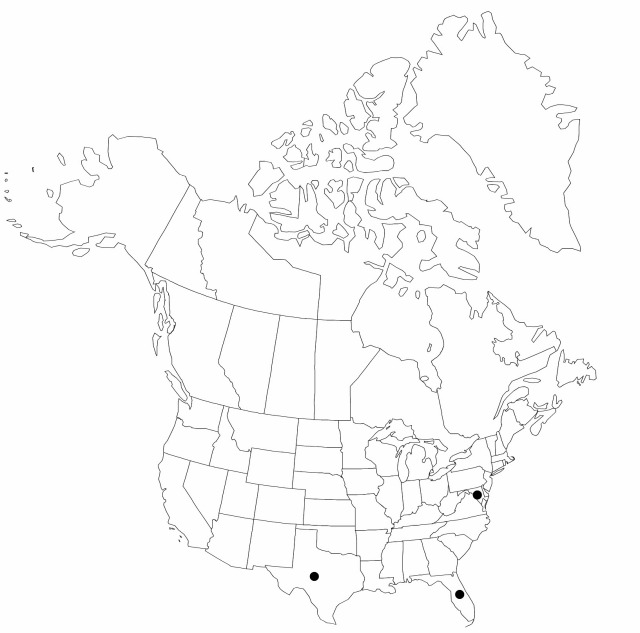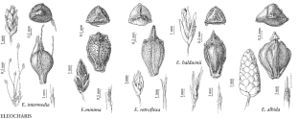Eleocharis minima
Enum. Pl. 2: 139. 1837.
Plants annual, tufted, often mat-forming, often stoloniferous, sometimes entirely vegetative; rhizomes absent. Culms erect, ascending or arching, quadrangular, sulcate, 1–13 cm × 0.1–0.3 mm, soft. Leaves: distal leaf-sheaths persistent or disintegrating, redbrown, stramineous, green, or mottled-redbrown, translucent, apex narrowly acute. Spikelets: basal spikelets often present, bisexual; often proliferous, ovoid or ellipsoid, laterally compressed when young, but terete at maturity, 2–7 × 1–2.6 mm, acute; proximal scale empty, often persistent, amplexicaulous, similar to floral scales; subproximal scale with a flower; floral scales spirodistichous (superficially appearing ± spiraled), (4–) 10–28, 6–9 per mm of rachilla, pale-brown, mottled-redbrown to purple, ovate or elliptic, 1.3–2.1 × 0.7–1 mm, membranous, midribs green and redbrown, prominent, apex rounded to obtuse. Flowers: perianth bristles 6, colorless, white, or stramineous, slightly shorter than to equaling achene, spinules retrorse, acute; stamens 3; anthers 0.4–0.5 mm; styles 3-fid. Achenes greenish or pale-brown or redbrown, often clearly spotted greenish or redbrown, ellipsoid to obovoid, trigonous (or terete?), angles prominent (keeled), 0.6–0.8 × 0.4–0.5 mm, apex constricted proximal to tubercle, smooth. Tubercles redbrown, pyramidal, trigonous, 0.1–0.3 × 0.2–0.4 mm.
Phenology: Fruiting mid spring–fall.
Habitat: Freshwater, sandy and peaty shores of lakes, muddy areas
Elevation: 0–400 m
Distribution

Fla., Md., Tex., Mexico, West Indies, Central America (Costa Rica), Central America (El Salvador), Central America (Guatemala), Central America (Nicaragua), Central America (Panama), South America
Discussion
Eleocharis minima is most often confused with E. bicolor and E. baldwinii (see comments under 33. E. bicolor). Although floral scales in E. minima often superficially appear to be spirally disposed, in reality they are spirodistichous, ± decussate, while in E. baldwinii they are strictly distichous in one plane. The number of floral scales per millimeter is much greater in E. minima than in E. baldwinii.
Selected References
None.
Lower Taxa
"shortened" is not a number.
